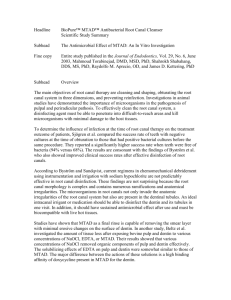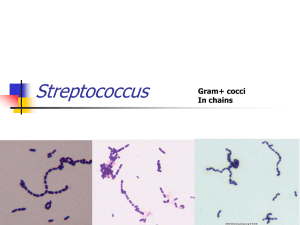the prevalence of alcaligenes faecalis in bacteremia, meningitis and
advertisement
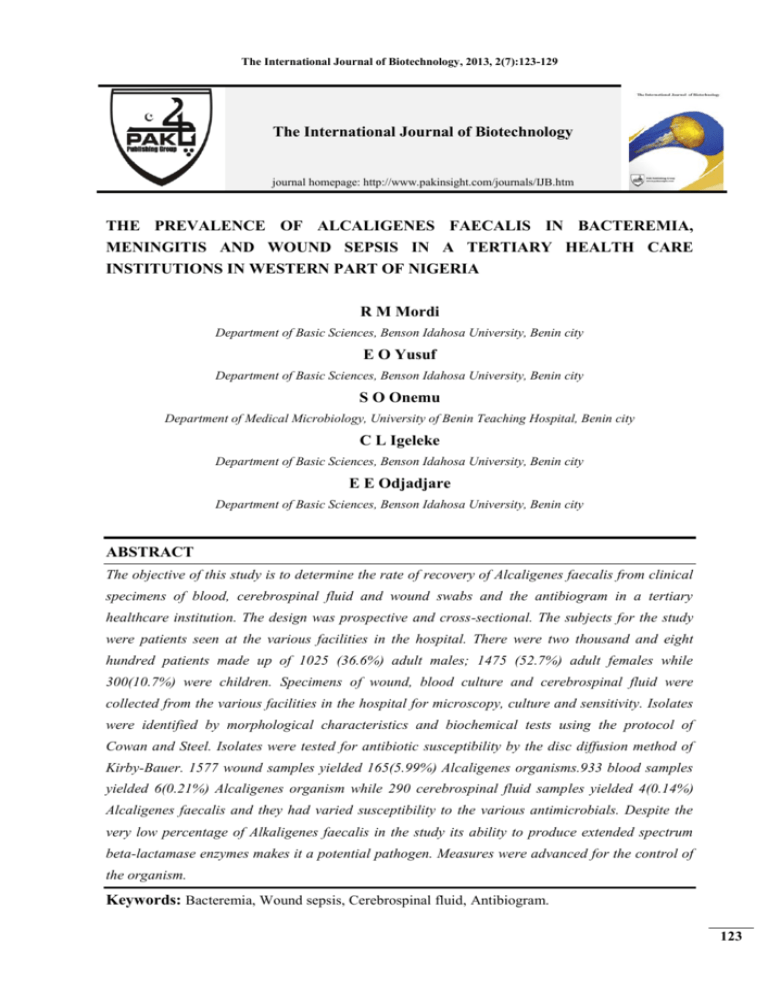
The International Journal of Biotechnology, 2013, 2(7):123-129 The International Journal of Biotechnology journal homepage: http://www.pakinsight.com/journals/IJB.htm THE PREVALENCE OF ALCALIGENES FAECALIS IN BACTEREMIA, MENINGITIS AND WOUND SEPSIS IN A TERTIARY HEALTH CARE INSTITUTIONS IN WESTERN PART OF NIGERIA R M Mordi Department of Basic Sciences, Benson Idahosa University, Benin city E O Yusuf Department of Basic Sciences, Benson Idahosa University, Benin city S O Onemu Department of Medical Microbiology, University of Benin Teaching Hospital, Benin city C L Igeleke Department of Basic Sciences, Benson Idahosa University, Benin city E E Odjadjare Department of Basic Sciences, Benson Idahosa University, Benin city ABSTRACT The objective of this study is to determine the rate of recovery of Alcaligenes faecalis from clinical specimens of blood, cerebrospinal fluid and wound swabs and the antibiogram in a tertiary healthcare institution. The design was prospective and cross-sectional. The subjects for the study were patients seen at the various facilities in the hospital. There were two thousand and eight hundred patients made up of 1025 (36.6%) adult males; 1475 (52.7%) adult females while 300(10.7%) were children. Specimens of wound, blood culture and cerebrospinal fluid were collected from the various facilities in the hospital for microscopy, culture and sensitivity. Isolates were identified by morphological characteristics and biochemical tests using the protocol of Cowan and Steel. Isolates were tested for antibiotic susceptibility by the disc diffusion method of Kirby-Bauer. 1577 wound samples yielded 165(5.99%) Alcaligenes organisms.933 blood samples yielded 6(0.21%) Alcaligenes organism while 290 cerebrospinal fluid samples yielded 4(0.14%) Alcaligenes faecalis and they had varied susceptibility to the various antimicrobials. Despite the very low percentage of Alkaligenes faecalis in the study its ability to produce extended spectrum beta-lactamase enzymes makes it a potential pathogen. Measures were advanced for the control of the organism. Keywords: Bacteremia, Wound sepsis, Cerebrospinal fluid, Antibiogram. 123 The International Journal of Biotechnology, 2013, 2(7):123-129 1. INTRODUCTION Morphological characteristics: Alcaligenes faecalis, an obligate aerobe that is commonly found in the environment, is gram negative, motile with peritrichous flagellae, and non pigmented rod.These characteristics differentiate this bacterium from other pseudomonads. (Bizet and Bizet, 1997). Biochemical characteristics: It is oxidase, citrate and catalase positive. It is non nitrate reducing or lactose-fermenting. It has ability to convert the most toxic varieties of arsenic acid, and arsenite to its less dangerous form-arsenate during growth in media containing these chemicals and it’s capable of degrading urea and producing ammonia which increases the pH of the environment. (Anderson et al., 2003). Epidemiology: The organism is found in aqueous environmental sources (Kavuncuoglu et al., 2010). Medical equipments and solutions have been found to be contaminated with this bacterium.(Bizet and Bizet, 1997) Pathology: The organism has been isolated from a range of clinical materials and also recognized as an opportunistic pathogen responsible for serious infections (Kavuncuoglu et al., 2010);(Chandhuri, 1967). This bacterium has been reported to cause meningitis in new born and bacteremia in cancer patients (Knippschill et al., 1996);(Ashwath and Katner, 2005), and has been associated with pancreatic abscess and corneal ulcer (Aisenberg et al., 2004);(Geong Ho Hwang et al., 2009). Reports have also indicated that Alcaligenes species have also been associated with bacteremia and respiratory infections (Manfredi et al., 1997) Systemic infections resulting from alcaligenes species have been described as usually severe and often lethal, and in addition, optimal antibiotic therapy is not well established (Chandhuri, 1967) Most strains have been reported to display multiple resistance to numerous antimicrobial agents which has been attributed to the production of extended spectrum beta-lactamases (ESBLs). (Mantengoli and Rossolini, 2005). There are scanty reports in the literature of the frequency of recovery of Alcaligenes faecalis from humans samples. The aim of this study is to determine the recovery rate of the organism from clinical specimens in a tertiary healthcare institution. 2. METHODOLOGY The study was carried out in a tertiary healthcare institution with bed compliment of 600.The tertiary healthcare institution is equipped with a standard Microbiology laboratory. and provides laboratory services to Edo state and the neighboring states. This study received the approval of the ethical committee of the hospital management following the submission of a research proposal in which the nature and the objective of the study were explained. The patients used for the study were those seen at the various facilities in the hospital. The patient population was 2800 consisting of 1025 (36.6%) males, 1475 (52.7%) females and 300 (10.7%) were children. The design of the study was prospective and cross-sectional. There was no particular order for the collection of samples except that they were consecutively obtained. Clinical samples consisted of 1577 (56.3.%) wound swabs, 933(33.3%) blood culture samples and 290(1 0.4%) cerebrospinal fluid samples (CSF). 124 The International Journal of Biotechnology, 2013, 2(7):123-129 Cultural Technique: Wound swabs were cultured on blood and McConkey agars. A pair of blood agar was inoculated. One plate was incubated aerobically while the other was incubated anaerobically. The culture was followed by Gram staining and microscopy.Anaerobic incubation was done by putting inoculated blood agar plates in an anaerobic jar and filling the jar with hydrogen gas. In the absence of hydrogen gas, an anaerobic gas generating kit- gas pack-® was used . It was opened at one edge and 10ml of water was added to the kit and the jar was closed immediately and not opened till the next day. Blood samples were incubated in a brain-heart infusion broth and thioglycollate broth. 1ml of blood was aseptically introduced into each of the bottles and incubated. Great attention was paid to aseptic technique to avoid introduction of micro-organisms which are not present in the inoculated blood. Growth normally manifests as turbidity or gas bubbles. The bottles were examined daily for growth. If growth was detected both broth cultures were sub cultured. The nutrient broth was subcultured onto chocolate, blood and McConkey agars and incubated aerobically, while the thioglycolate broth was sub cultured onto blood agar plate and incubated an aerobically. After the subculture Gram staining and microscopy were prepared and read. The manual blood culture technique is still preferred locally in spite of the automated system, mainly because of cost considerations and lack of adequately trained maintenance personnel. Cerebrospinal fluid was cultured as soon as it is collected. After the culture on chocolate, blood and McConkey agars, Gram staining and microscopy were prepared and read. Chocolate agar plate was incubated in a candle jar for carbon dioxide enriched atmosphere. Plates were incubated for 24hrs. The samples were also analyzed for protein and sugar levels. Isolates were identified by morphological and biochemical characteristics using the protocol of Cowan and Steel (Cowan and Steel, 1974). The susceptibility of the isolates was determined by a modification of the disc agar diffusion method, of Kirby-Bauer. (Bauer et al., 1996) Susceptibility testing done on Mueller-Hinton agar, Blood or Chocolate agars depending on the nature of the isolate. Fastidious organisms will require blood or chocolate agars for sensitivity testing. Each isolate inoculums were prepared using the McFarlane standard (Andrew, 2004). The antibiotics and their disc concentrations were: ceftazidime 5ug, ofloxacin 5ug, amoxicillin clavulanate 10ug, gentamycin 10ug, cefuroxime 30ug, ceftriazone 10ug, azithromax 10ug and cloxacillin 5ug. With sterile forceps commercially prepared antibiotics were aseptically placed at least 25mm apart on the plates. Coliforms and nonfastidious organisms were inoculated on Mueller-Hinton agar while blood or chocolate agars were used for the fastidious isolates. These were incubated overnight at 370c The zone of inhibition was measured and compared with control. A standard sensitive strain Escherichia coli Cw 3310 was included as a control organism. Resistance to any antibiotic was represented by “R” while “S” indicated that the organism was susceptible to the antibiotic. 125 The International Journal of Biotechnology, 2013, 2(7):123-129 3. RESULTS Twelve bacterial species were isolated in the study (Table1). 1577(56.3%) wound samples yielded 165 (5.99%) isolates of Alcaligenes faecalis. 933 (33.3%) blood samples yielded 6(0.21%) Alcaligenes faecalis while 290 (10.4%) cerebrospinal fluid samples yielded 4 (0.14%) A. faecalis, that had increased protein and reduced sugar levels. Other isolates were also shown (Table 2 ). The antibiotic activity of ceftazidime (91%) and ofloxacin (69.1%) was encouraging while moderately susceptible to amoxicillin clavulanate (49.1%), gentamycin (58.9%) ceftriazone (45.7%) and azithromax (48.6%). It however, showed a high resistance to Cefuroxime (25.7%) and cloxacillin (2.9%) (Table3). Table- 1. Isolates and their number. Alcaligenes faecalis Pseudomonas aeruginosa Escherichia coli Klebsiella pneumoniae Staphylococcus aureus Proteus mirabilis Proteus vulgaris Providencia stuartii Acinetobacter calcoaceticus Citrobacter freundii Enterobacter aerogenes Morganella morganii 175 364 410 312 1022 117 97 86 94 40 37 15 Table-2. Shows type of specimens and number; and Isolates and Percentages (%) Table- 3. Susceptibility of Alcaligenes faecalis to tested antibiotics number % Caz 160 91.1% Ofx 122 69.1% Aug 86 49.1% CN 103 58.9% CXM 45 25.7% CRO 80 45.7% AZN 85 48.6% OB 5 2.9% Footnote: Caz=ceftazidime Ofx= ofloxacin Aug=amoxicillin clavulanate Cn= gentamycin Cxm=cefotaxime 126 The International Journal of Biotechnology, 2013, 2(7):123-129 Cro = ceftriazone Azn =azithromicin Ob =cloxacillin 4. DISCUSSION The prevalence value of 6.3% for Alcaligenes faecalis is low but however, clinically significant. A study of cultured deep wound surgical specimens in orthopedic practice – a metropolitan hospital based study recorded a prevalence value of 3.57% (Bizet et al., 1993). It will seem that it’s distribution is generally low and this study corroborates the observation that it is rarely isolated from humans (Bizet and Bizet, 1997). The organism is observed to be an opportunistic pathogen as is often isolated from immunocompromised patients, especially those on vascular catheter and patients on cancer treatment (Kavuncuoglu et al., 2010);(Ashwath and Katner, 2005). From the statistic of this study it means that in 1577 wound samples there is 5.9% chance of isolating Alcaligenes faecalis and 0.2% chance in 933 blood culture samples while it is 0.14% chance in 290 cerebrospinal fluid samples. The rate of recovery of the organism from clinical specimens is much more in wounds than blood samples or cerebrospinal fluid. This means that blood samples and cerebrospinal fluids are less likely to yield growth of Alcaligenes faecalis. This explains the very low frequency of recovery of the organism from blood and cerebrospinal fluid samples. The susceptibility of the organism to ceftazidime, ofloxacin and gentamycin was encouraging. It was moderately susceptible to amoxicillin clavulanate, azithromycin and ceftriazone but resistant to cefuroxime and cloxacillin. Resistance of Alcaligenes faecalis to several antibiotics has been widely reported (Bizet et al., 1993). In the present study the isolates were all susceptible to ceftazidime gentamycin and ofloxacin contrary to the earlier report from a French study. (Bizet et al., 1993). Resistance to cefotaxime and cloxacillin was however confirmed. The high resistance pattern of the isolates in the present study can be explained in part to the organism’s ability to produce extended spectrum –Beta-lactamase enzymes (Veronique Dubois et al., 2006), which destroy the penicillins and the cephalosporins. 5. CONCLUSION This study has identified wound as the commonest clinical material from which Alcaligenes faecalis can be isolated. Other sources are much less significant. The presence of this microorganism in soil and water enhances its chance of contaminating wounds and initiating opportunistic infections in hospitals and in individuals who are immunocompromised. Patients in nursing homes and those receiving immunosuppressive therapy should therefore be adequately protected from being infected with Alcaligenes faecalis that was hitherto considered uncommon organism. 127 The International Journal of Biotechnology, 2013, 2(7):123-129 5.1. Conflict Of Interest Statement The authors declare no conflict of interest. 6. ACKNOWLEDGEMENTS We sincerely acknowledge the contributions of Mrs EN Mordi for typing the manuscript and Christopher Iyioriobhe for editing the manuscript. REFERENCE Aisenberg, G., K.V. Rolston and A. Safda, 2004. Bacteremia caused by Achromobacter and Alcaligenes species in 46 patients with cancer.(1989-2003) Cancer, 101:(9) 2134-2140. Anderson, G.L., M. Love and B.K. Zeider, 2003. Metabolic energy from arsenite oxidation in alcaligenes faecalis. J. Pysi. Iv France, 107: 49. Andrew, J.M., 2004. British scientific antimicrobial chemotherapy (BSAC) working party on susceptibility testing- Standardized Disc Susceptibility Testing Method. JAC, 53(3): 713-728. Ashwath, M. and H.P. Katner, 2005. Pancreatic abscess secondary to alcaligenes faecalis am. J Med. Sci, 329(1): 54-55. Bauer, W.A., M.W. Kirby, J.C. Sherris and M. Truck, 1996. Antibiotic susceptibility testing by standardized single disc method. Amer. J. Clin. Path, 45(4).493-496 Bizet, C., F. Tekaia and A. Philippon, 1993. In-vitro susceptibility of alcaligenes faecalis compared with those of other alcaligenes species to antimicrobial agents including seven b-lactams. J. Antimicrob. Chemother, 32: 907-910. Bizet, J. and C. Bizet, 1997. Strains of alcaligenes faecalis from clinical material. J. Infect, 35(2):167-169. Chandhuri, K.C., 1967. Alcaligenes faecalis, a cause of septicemia and meningitis in the new born Indian J. of Pediatrics, 34(3): 242-244. Cowan, S.T. and K.J. Steel, 1974. Manual for the identification of medicalbacteria 2nd Edn., London Cambridge University Press. Geong Ho Hwang, Min Jung Kim, Eui Yung Kweun, M. Ahn and I. Cheon, 2009. A case of corneal ulcer by alcaligenes faecalis J Korean Ophthalmol Soc, 50(9): 14141477. Kavuncuoglu, F., A. Unal, N. Oguzhan, B. Tokgoz, O. Oymak and C. Udas, 2010. Outbreak of alcaligenes faecalis pseudobacteremia in neontology and pediatric units. J. Hosp. Infect 74(4): 397-399. Knippschill, M., N. Ernst, U. Schmid, M, K. Erika, M. Meusser, G. Brittinger and H. Hoffkes, 1996. Infection of alcaligenes xylosoxidans sub species xylosoxidans in neutropenic patients. Oncology, 53(3): 258-262. 128 The International Journal of Biotechnology, 2013, 2(7):123-129 Manfredi, R., A. Nanetti, M. Ferri and F. Chiodo, 1997. Bacteremia and respiratory involment of alcaligenes xylosoxidans in patients infected with hiv. Eur. J Clin. Microbiol. Infect Dis, 16(12): 933-938. Mantengoli, E. and G.M. Rossolini, 2005. Tn5393d a complex tn5393 derivative carrying the per -1 extended spectrum b-lactamase gene and other resistance determinants. Antimicro. Agents Chemother, 49(8): 3289-3296. Veronique Dubois, Corinne Arpin, Laure Coulange, Catherine Andre, Patrick Noury and C. Quentin, 2006. Tem-21 extended spectrum b-lactamase in a clinical isolate of alcaligenes faecalis from a nursing home. J. Antimicrob Chemother, 57(2): 368369. 129
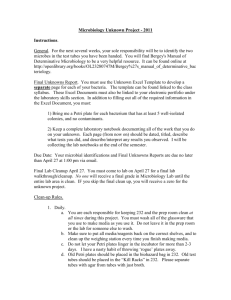
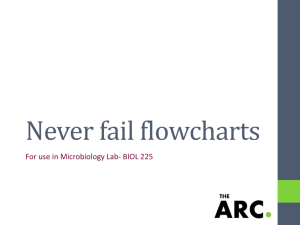
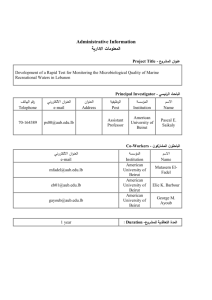
![medicine3_33[^]](http://s3.studylib.net/store/data/007298585_1-a62be5f279aa0f8ef6282c4c51ca07b8-300x300.png)



